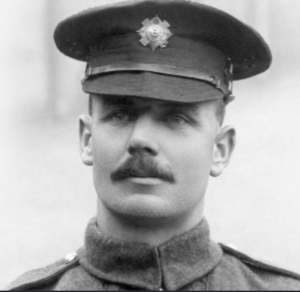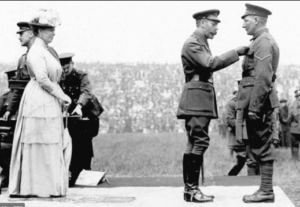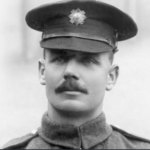
Harry Blanshard Wood was born on the 21st of June 1882 at Pocklington, North Yorkshire, and joined the Scots Guards on the 3rd of February 1903.
After the outbreak of WW1, in August 1914, Harry Wood was recalled from the Army Reserve and from October 1914 served with the 2nd Battalion Scots Guards.
In the Autumn of 1915, Harry took part in the Battle of Loos, the first battle in which the newly formed Guards Division was involved.
For most conspicuous bravery and devotion to duty during operations at the village of St. Python, France, on the 13th of October 1918. The advance was desperately opposed by machine guns and the streets were raked by fire. His platoon sergeant was killed and command of the leading platoon fell to him.
The task of the company was to clear the western side of the village and secure the crossing of the River Selle. Command of the ruined bridge had to be gained, though the space in front of it was covered by snipers.
Harry boldly carried a large brick out into the open space, laid down behind it, and fired continually at these snipers, ordering his men to work across while he covered them by his fire. This he continued to do under heavy and well-aimed fire until the whole of his party had reached the objective point.

He showed complete disregard for his personal safety, and his leadership throughout the day was of the highest order. Later, he drove off repeated enemy counter-attacks against his position. His gallant conduct and initiative shown, contributed largely to the success of the day’s operations.
Harry Wood was invested with his Victoria Cross by King George V at Buckingham Palace on the 22nd February 1919.
For the award of the Military Medal.
Having lost his bearings in No-Mans-Land, Harry arrived at the enemy trenches. At the same time, he, unfortunately, made a noise that attracted a group of German soldiers, who quickly surrounded him.
Reacting quickly, Harry shot two of them and wounded another. The German soldiers were slow to respond, and Harry took the wounded man as a hostage, before escaping. Later, Harry’s captured German was discovered to have important papers on him.
Holiday in Teignmouth, Devon
His nerves were badly affected by his wartime experiences. He died 15 August 1924 whilst on holiday; he was walking with his wife when a car mounted the pavement and headed towards them. His wife pushed him out of the way, but she was pinned against the wall. She suffered minor injuries, but her husband was so shocked that he collapsed and fell into a coma from which he died several days later.[He was buried at Arnos Vale Cemetery, Bristol, England, at Soldiers’ Corner, grave number 1738.
Harry Wood was only 42 years of age and was buried in Arnos Vale Cemetery, Bristol. His Victoria Cross is in the possession of the York Castle Museum, York.

A ceremony, organised by the South Western Branch Scots Guards Association, took place in Arnos Vale Cemetery, Bristol, on the 27th of October 2001 to erect a replacement headstone over the grave of Corporal Harry Blanshard Wood VC, MM.
